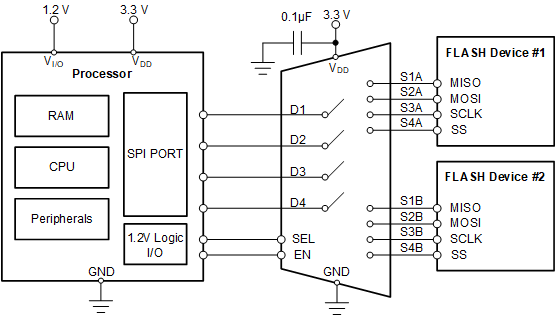SCDS423 October 2020 TMUX1575
PRODUCTION DATA
- 1 Features
- 2 Applications
- 3 Description
- 4 Revision History
- 5 Pin Configuration and Functions
- 6 Specifications
- 7 Parameter Measurement Information
- 8 Detailed Description
- 9 Application and Implementation
- 10Power Supply Recommendations
- 11Layout
- 12Device and Documentation Support
- 13Mechanical, Packaging, and Orderable Information
Package Options
Mechanical Data (Package|Pins)
- YCJ|16
Thermal pad, mechanical data (Package|Pins)
Orderable Information
9.1 Typical Application
Common applications that require the features of the TMUX1575 include multiplexing various protocols from a possessor or MCU such as SPI, JTAG, eMMC, or standard GPIO signals. The TMUX1575 provides superior isolation performance when the device is powered. The added benefit of powered-off protection allows a system to minimize complexity by eliminating the need for power sequencing in hot-swap and live insertion applications. The example shown in Figure 9-1 illustrates the use of the TMUX1575 to multiplex an SPI bus to multiple flash memory devices.
 Figure 9-1 Multiplexing Flash Memory
Figure 9-1 Multiplexing Flash Memory